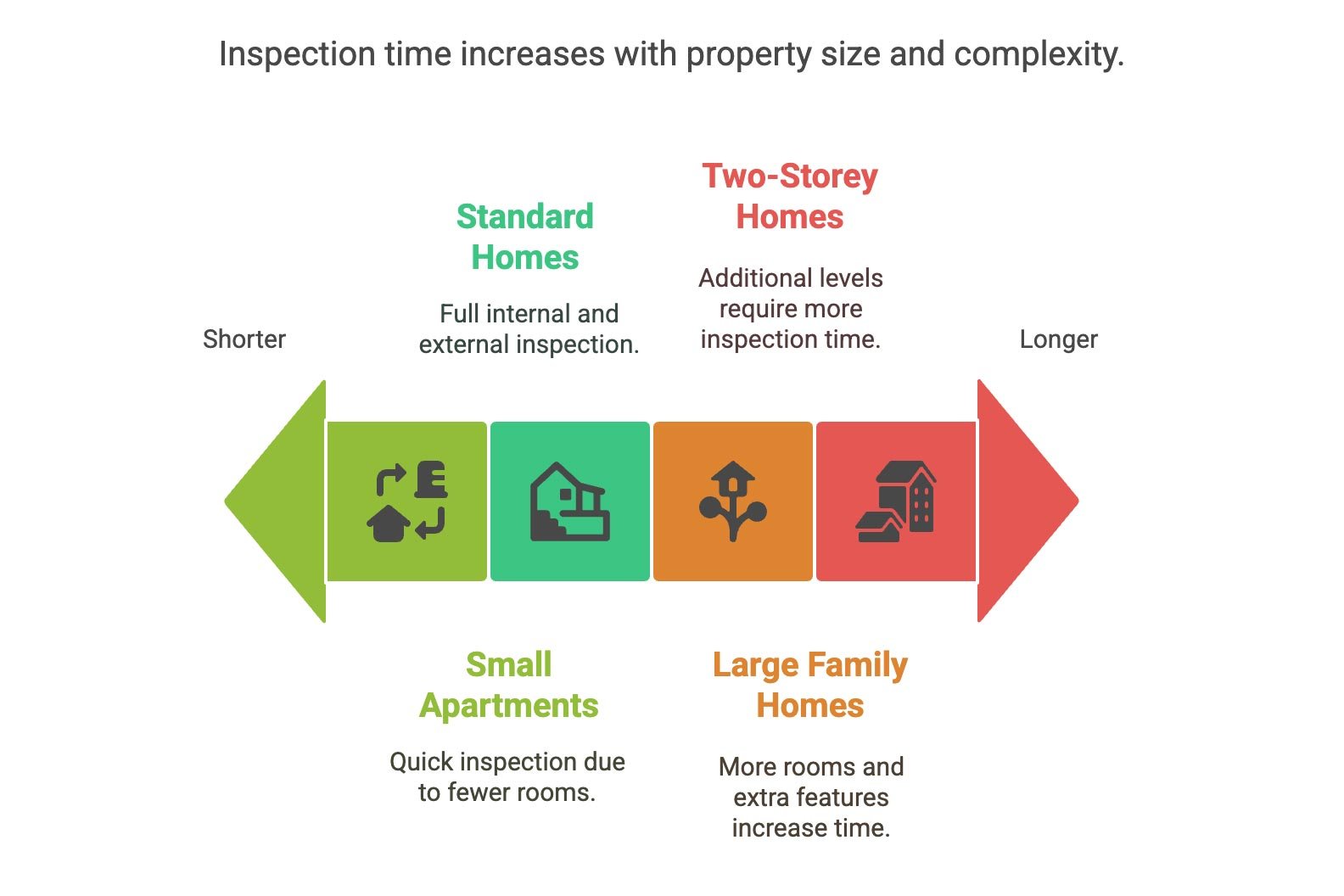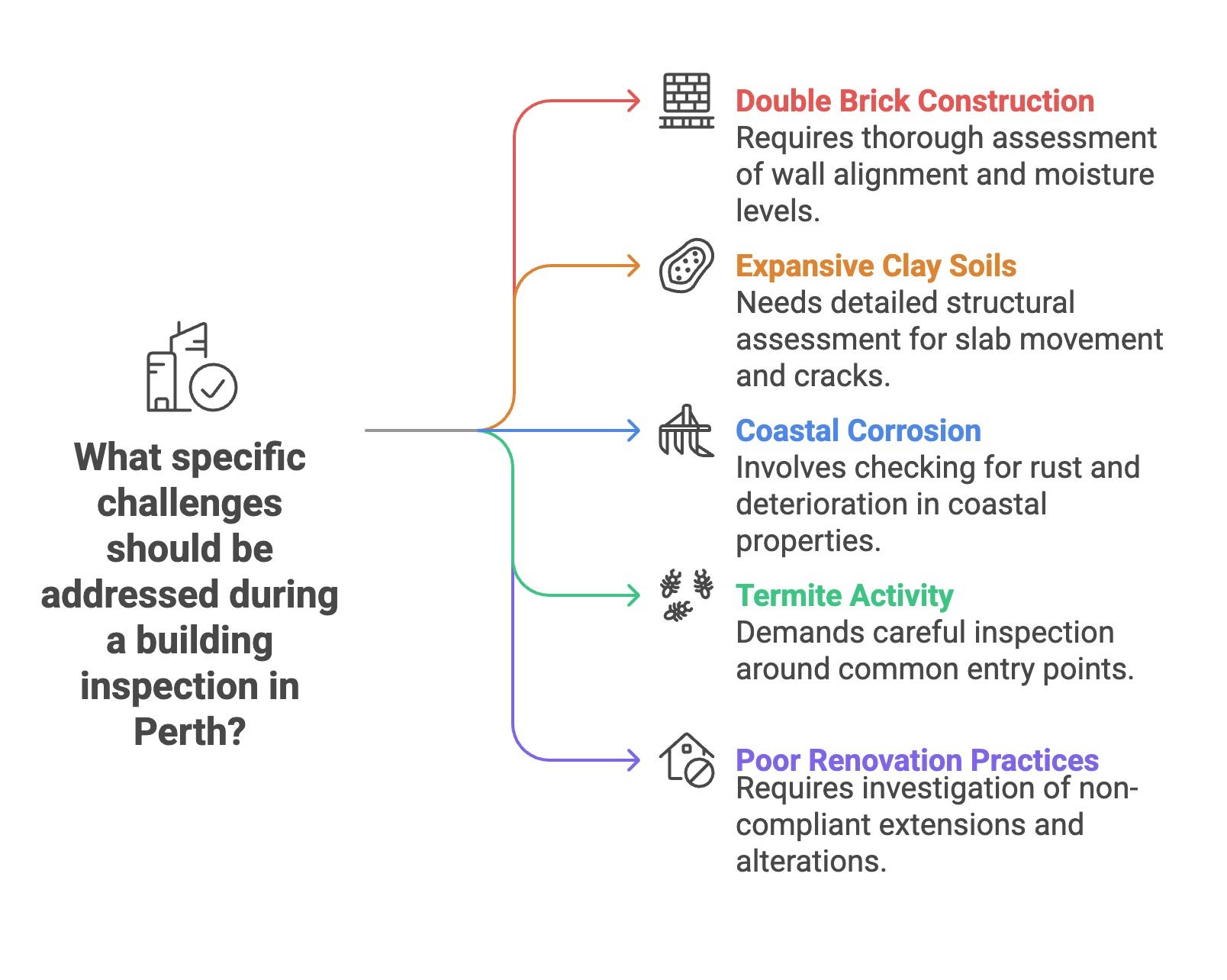How Long Does a Building Inspection Take in Perth? Complete Guide
G'day! As a local building inspector here in Perth, I get asked this question almost daily: "How long does a building inspection take?" It's totally understandable – you're trying to plan your day, maybe taking time off work, or coordinating with real estate agents. After 15 years of crawling through homes, I can honestly say there's no one-size-fits-all answer.
The short answer? Most building inspections take between 1.5 to 3 hours. But I’ve seen quick 1-hour inspections for small units, and I’ve spent an entire day on sprawling heritage homes in suburbs like Fremantle.
Let me walk you through what actually determines how long your building inspection will take, because understanding this will help you plan better and get more value from your inspection.
What Exactly Am I Looking For During Your Building Inspection?
Before we dive into timing, let me explain what happens during a building inspection. Think of me as a detective with a clipboard and a torch. I'm checking every nook and cranny of your property to spot issues that could cost you thousands down the track.
I'll be examining your roof (yes, I actually climb up there!), checking structural elements, testing electrical appliances, inspecting water leaks, looking for pests, and much more. It's like giving your house a comprehensive health check. See a full list of what’s covered in a Perth building inspection.
How Long Will Your Building Inspection Actually Take?
Here's where I get specific about timing, based on what I see daily in Perth suburbs:
Age of Your Home
-
Common in areas like East Perth and South Perth, these compact spaces are quicker to inspect due to fewer rooms. Still, inspectors check all key areas like moisture levels and internal finishes thoroughly.
-
Typical in suburbs like Morley and Balcatta, these homes allow for a full internal and external inspection without being too time-consuming. Roof voids and subfloors (if accessible) are usually included
-
Found in areas like Dalkeith or Mount Pleasant, these homes have more rooms, bigger roof areas, and features like pools or granny flats. That adds inspection time due to the extra elements involved.
-
Common in estates like Ellenbrook and Alkimos, two-storey properties take longer due to extra levels, staircases, and upper roof zones that require more time and care to inspect safely.
Specific Property Challenges
Living in Perth, you'll know we have everything from 1950s weatherboard homes to brand new builds in Ellenbrook. This affects timing significantly:
Older Perth homes (pre-1980s)
These beauties take longer because there's usually more to find. They're gorgeous, but I need extra time to check for asbestos, plumbing leaks, and structural settling.Modern homes (post-2000)
Generally quicker inspections as everything's more accessible and built to current standards. Usually straightforward.Heritage properties
If you're looking at one of the heritage gems, block out a full day. These require special attention and often reveal fascinating (and expensive) surprises.
Factors Affecting Inspection Time
Let me share some real examples from my Perth inspections:
Locked or Blocked Roof Voids
Accessing the roof space (ceiling cavity) is crucial for checking insulation, structural framing, and signs of leaks or pests. If the manhole is locked, covered with furniture, or built too small, the inspector may be unable to assess it properly.Inaccessible Subfloors
For homes with timber floors, the subfloor area needs inspection for moisture issues, structural damage, or termite activity. If it's too low, sealed off, or filled with stored items, it becomes impossible to inspect safely.No Access to Garage or Shed
Detached garages, workshops, or garden sheds can hide issues like structural movement, roof leaks, or termite damage. If the keys aren't available or the areas are cluttered, these spaces may be skipped or only partially inspected.Overgrown Vegetation or Debris
Heavy vegetation, rubbish, or garden beds built up around the house can block visual access to external walls, weep holes, and slab edges – all of which are key inspection points for water ingress or termite entry.Tenanted or Occupied Homes
If tenants or owners aren’t informed in advance, inspectors may not be allowed into certain rooms, especially bedrooms, attics, or storage spaces. This lack of full access can limit the report’s accuracy and completeness.
Perth's Unique Challenges
Our Perth climate and building styles create specific timing considerations:
Double Brick Construction
Perth homes are predominantly built with double brick, which can hide cracks, moisture ingress, or structural movement within wall cavities. Inspectors often take extra time to assess internal and external wall alignment and use moisture meters more thoroughly.Expansive Clay Soils (Especially in Northern Suburbs)
Many Perth suburbs – especially in the north – are built on reactive clay soils that expand and contract with moisture. This causes slab movement, wall cracks, and uneven floors, requiring a more detailed structural assessment during the inspection.Coastal Corrosion
Properties near coastal areas like Fremantle, Cottesloe, or Rockingham are prone to salt-induced corrosion of metal fixtures, roof sheets, and structural elements. Inspectors must carefully check for early signs of rust and deterioration, which adds time.High Risk of Termite Activity
Due to Perth’s warm climate and widespread use of timber framing in extensions or older homes, termite inspections require extra attention—especially around garden beds, subfloors, and fence lines, which are common termite entry points.Poor Renovation Practices
Perth has seen a boom in DIY and budget renovations. Inspectors often need to investigate non-compliant extensions, poorly waterproofed wet areas, or hidden structural alterations—especially in older suburbs like Victoria Park or Mount Lawley.
Weather-Related Factors
Heavy Rain
Most critical factor. Makes roof access unsafe, floods subfloors, and interferes with moisture detection tools. Can obscure leaks or make it difficult to tell if water ingress is active or historic.Extreme Heat (Summer Roof Voids)
Perth summers can make roof spaces dangerously hot (50°C+), limiting time inspectors can safely spend inside. Often results in partial inspections or revisits for complete assessment.Strong Winds
Prevents safe use of ladders and roof access, particularly for metal or tiled roofs. Can lead to rescheduling of external or roof inspections.
Other factors like humidity or morning dew are minor in Perth, unless the inspection is first thing in winter. They're less likely to delay the inspection but may affect certain readings (like moisture levels).
Tips to Ensure an Efficient Inspection
After thousands of Perth inspections, here's how you can help the process run smoothly:
Before the Inspector Arrives:
Clear the path: I need access to your roof manhole, electrical box, hot water system, and around the house perimeter.
Turn everything on: Power, water, gas – I need to test all systems.
Gather your paperwork: Previous inspection reports, renovation permits, or warranty documents help me focus on known issues.
During the Inspection:
Stick around: I encourage clients to follow me around (safely). Ask questions!
Take notes: Write down issues or tips I point out.
Don't rush me: Thorough inspections take time. Rushing leads to missed issues.
Understanding Your Inspection Report Timeline
Getting Your Report:
Same day: I'll give you a verbal summary of major findings immediately after inspection.
Within 24 hours: You'll receive my comprehensive written report with photos, detailed findings, and recommendations.
Rush jobs: Available for urgent situations, but I prefer the standard timeline to ensure thoroughness.
What's in Your Report:
Detailed findings with photos
Priority ratings for issues found
Maintenance recommendations
Cost estimates were appropriate
Explanations in plain English (no confusing jargon!)
Making the Most of Your Investment
During the Inspection:
Ask about maintenance schedules
Learn how your home's systems work
Understand which issues are urgent vs. long-term
Get tips for preventing future problems
After Receiving Your Report:
Read everything, not just the summary
Contact me with questions – I'm always happy to clarify
Use the report for maintenance planning
The Bottom Line from Your Local Perth Inspector
So, how long does a building inspection take? For most Perth homes, plan on 1.5–3 hours for a thorough job. But remember, I'd rather take an extra hour and find that hidden termite damage than rush through and miss something that could cost you $20,000 later.
I've been inspecting Perth homes since 2008. Every property tells a story, and my job is to read that story for you. Some stories are quick reads, others are epic novels that require patience and attention to detail.
Whether you're buying your first home in Wanneroo, upgrading to something bigger in Nedlands, or investing in a property in Rockingham, a thorough building inspection is worth every minute it takes.
Ready to book your inspection? As a local Perth building inspector, I know this city's housing stock inside and out. I'll give it to you straight – no sugar-coating, no unnecessary drama, just honest assessment from someone who's seen it all in Perth's property market.
Give me a call, and let's make sure your next property decision is an informed one. Because in my experience, the time we spend on a thorough inspection now can save you months of headaches and thousands of dollars later.
FAQ
1. How long does a pre-purchase building inspection take in Perth?
Most pre-purchase inspections in Perth take between 1.5 to 3 hours, depending on the property's size, age, and access conditions.
2. Can I attend the building inspection?
Yes, and it’s encouraged. Attending the inspection allows you to ask questions, see issues firsthand, and better understand the condition of the property.
3. Do building inspections include pest inspections?
Not always. Pest inspections (especially for termites) are usually a separate service, but many Perth inspectors offer combined building and pest inspections for convenience.
4. How much does a building inspection cost in Perth?
Costs typically range from $300 to $700+ depending on the type and size of the property, as well as whether pest inspection is included.
5. What happens if the inspector finds a major issue?
You’ll receive a detailed report outlining the issue, its severity, and recommended next steps. You can use this to renegotiate, request repairs, or make an informed decision.
6. Do I need to prepare my home for the inspection?
Yes. Clear access to areas like the roof void, subfloor, meter boxes, and around the perimeter helps ensure a thorough inspection.
7. How soon will I get the inspection report?
Most inspectors provide the full report within 24 hours of the inspection, often with a same-day verbal summary.
8. What areas of the property are inspected?
A standard inspection covers the roof, interior, exterior, roof void, subfloor (if accessible), plumbing fixtures, electrical fittings, and structural elements.
9. Is a building inspection necessary for new homes?
Absolutely. Even new builds can have construction defects or incomplete finishes. Inspections help ensure the builder has met all standards.
10. How do I choose a good building inspector in Perth?
Look for an inspector with local experience, insurance, relevant certifications, and strong reviews. Ask if they follow Australian Standards and provide detailed, easy-to-understand reports.





